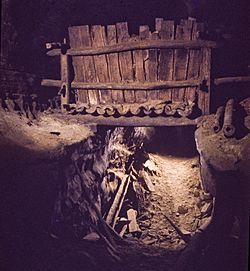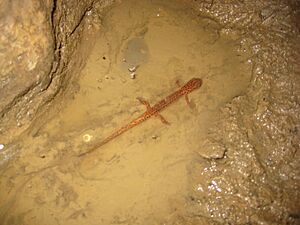Big Bone Cave facts for kids
Quick facts for kids Big Bone Cave |
|
|---|---|

Civil-war era saltpeter vat in Big Bone Cave
|
|
| Location | Van Buren County, Tennessee, United States |
| Length | 9.627 m (15.494 km) |
| Discovery | c. 1810 |
| Geology | Monteagle Limestone |
| Entrances | 2 |
| List of entrances |
Main Entrance (collapsed), Arch Cave Entrance |
| Hazards | histoplasmosis |
| Access | restricted |
| Website | TDEC: Big Bone Cave |
|
Big Bone Cave
|
|
| Location | Van Buren County, Tennessee, United States |
| Nearest city | Bone Cave, Tennessee |
| Area | 400 acres (160 ha) |
| NRHP reference No. | 73001853 |
| Added to NRHP | April 11, 1973 |
Big Bone Cave is a famous cave in Van Buren County, Tennessee. It is located near the community of Bone Cave, which was named after the cave. This cave is special for its long history and for being a fun place to explore.
Big Bone Cave is listed on the National Register of Historic Places. It is also a National Natural Landmark. This means it is a very important natural and historical site. The cave and the land around it make up a 400-acre (160 ha) State Natural Area. It is managed by Rock Island State Park. The cave got its name in 1811 when bones of a giant ground sloth were found inside.
Contents
History of Big Bone Cave
Big Bone Cave has a rich history. It was used as a mine for saltpeter. Saltpeter is a mineral used to make gunpowder. Mining was especially important during the War of 1812 and the American Civil War.
The dry air inside the cave has helped preserve many natural remains. It has also kept human tools and items safe for a very long time. These preserved items help us learn about the past.
How Big Bone Cave Formed
Big Bone Cave formed in a type of rock called Monteagle Limestone. This rock formed millions of years ago. The cave is located on the western edge of the Cumberland Plateau.
Scientists have studied how old the cave is. They used special dating methods on pebbles found inside. These pebbles show that the cave started forming more than 5.7 million years ago.
Long passages in the cave were created when the water level was stable. At that time, the climate was warmer. Also, sea levels were higher, which affected how rivers flowed. The Cumberland River used to flow across the Highland Rim.
Around 3.2 to 3.1 million years ago, the Earth's climate got colder. This caused sea levels to drop a lot, about 75 to 100 meters. This drop made rivers carve deeper into the land. The Cumberland River cut into the Highland Rim. Its smaller rivers, like the Collins River, cut into the Cumberland Plateau.
As the rivers cut deeper, the water level inside the cave dropped. This drained the water that filled the caverns. Over time, more erosion separated Bone Cave Mountain from the rest of the Cumberland Plateau.
Animals in Big Bone Cave
Caves are home to many unique creatures. One animal you might find in Big Bone Cave is the cave salamander. These salamanders are specially adapted to live in dark, damp cave environments. They often have bright colors.
Visiting Big Bone Cave
Big Bone Cave is a protected area. Access to the cave is restricted to help preserve it. If you want to visit, you usually need to be part of an organized trip or have special permission. This helps protect the cave's delicate environment and its historical treasures.
The cave is the 10th longest mapped cave in Tennessee. Exploring it can be an amazing experience. However, it's important to be aware of hazards like histoplasmosis. This is a lung infection caused by a fungus found in some cave environments.
Further Reading
- Smyre, John L. and Zawislak, Ronald L., Big Bone and the Caves of Bone Cave Mountain, (2007) Rocky River Press, Rock Island Tennessee, ISBN: 978-0-9779471-0-2.
- Matthews, Larry E. Big Bone Cave, (2006) National Speleological Society, ISBN: 1-879961-24-5.
- Barr, Thomas C., Jr., Caves Of Tennessee, (1961) Bulletin 64 of the Tennessee Division of Geology, See pages 451-460.



